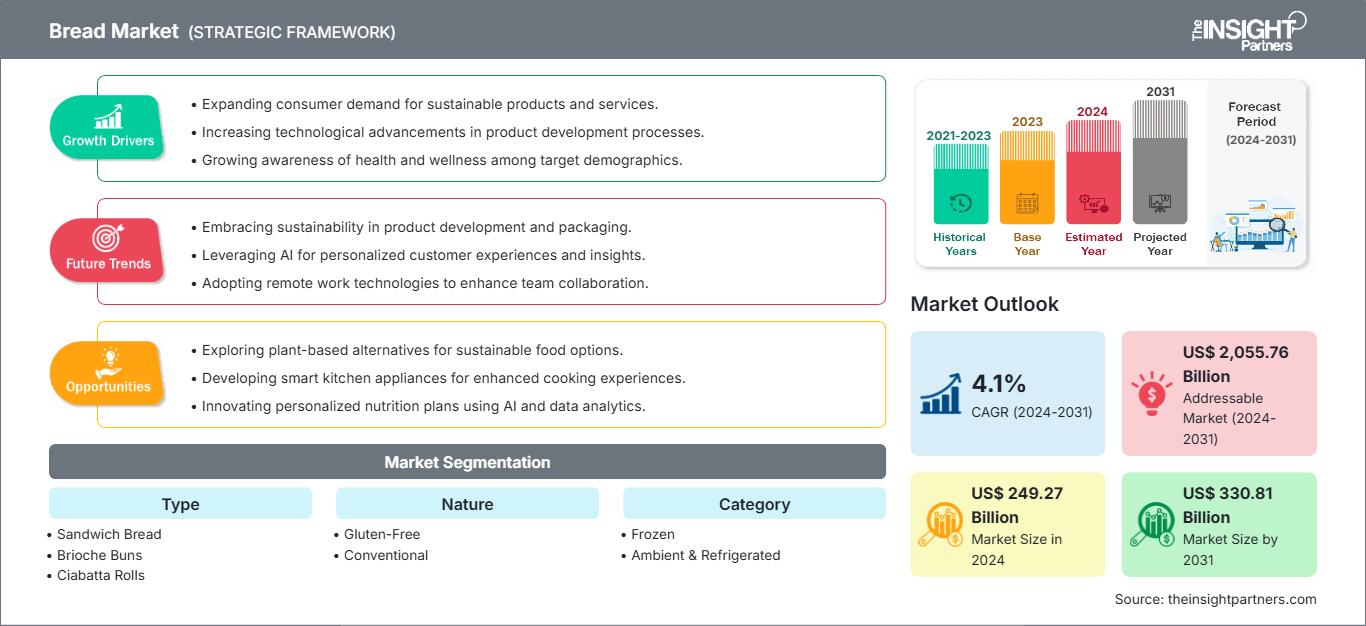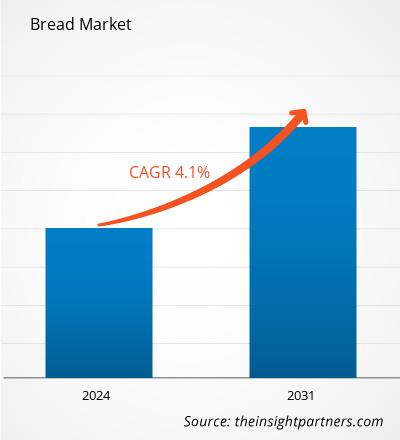Der Brotmarkt soll von 249,27 Milliarden US-Dollar im Jahr 2024 auf 330,81 Milliarden US-Dollar im Jahr 2031 anwachsen. Für den Markt wird zwischen 2024 und 2031 eine durchschnittliche jährliche Wachstumsrate (CAGR) von 4,1 % erwartet. Die steigende Beliebtheit glutenfreier Produkte dürfte im Prognosezeitraum neue Trends auf dem Markt mit sich bringen.
Brotmarktanalyse
Unternehmen im Brotmarkt weltweit erleben einen Nachfrageschub aufgrund der zunehmenden Vorliebe für Convenience- und Fertigprodukte. Der vorwiegend hektische Lebensstil und der Bedarf an schnellen und einfachen Mahlzeiten haben weltweit zu einem deutlichen Anstieg des Brotkonsums geführt. Die Verbraucher wählen glutenfreie, kohlenhydratarme, ballaststoffreiche oder Vollkornbrotprodukte anhand der auf dem Etikett angegebenen Zutaten aus. Veränderte Verbraucherpräferenzen und eine zunehmende Vorliebe für gesündere Alternativen haben zu einer Nachfrage nach Bio-Brot, -Baguettes, -Bagels sowie -Brötchen geführt. Brothersteller reagieren darauf mit umfangreichen Produktinnovationen und bieten handwerklich hergestelltes Brot, funktionelles Brot und angereichertes Brot mit funktionellen Zutaten wie Samen, Nüssen, alten Getreidesorten, Gemüse sowie verschiedenen Vitaminen und Mineralstoffen an. Die veränderten Geschmacksbedürfnisse der Verbraucher haben daher zu einer hohen Nachfrage nach Spezial- und funktionellem Brot geführt, was Brotherstellern lukrative Geschäftsmöglichkeiten bieten dürfte.
Marktübersicht Brot
Brot ist ein weltweit geschätztes Grundnahrungsmittel. Es blickt auf eine jahrtausendealte Geschichte zurück und ist fester Bestandteil der kulinarischen Traditionen verschiedener Kulturen. Von geschnittenem Brot bis hin zu Baguettes und Bagels – jede Region hat einzigartige Brotsorten, die lokale Aromen und Bräuche widerspiegeln. Es wird aus Teig hergestellt, der aus Mehl (Weizen, Gerste, Hafer, Roggen und anderen Mehlsorten), Hefe und Zucker, oft durch Backen, hergestellt wird. Es ist in weiten Teilen der Welt ein wichtiges Nahrungsmittel. Es ist eines der ältesten industriell hergestellten Backwaren und hat seit den Anfängen der Landwirtschaft eine bedeutende Bedeutung. Es hat auch maßgeblich zur Wiederherstellung eines wesentlichen Bestandteils religiöser Zeremonien und der Alltagskultur beigetragen. Es ist ein alltägliches Lebensmittel in Haushalten, Restaurants und Cafés und wird darüber hinaus häufig in Rezepten wie Sandwiches und Brötchen verwendet. Die wachsende Zahl berufstätiger Menschen, hektische Arbeitsabläufe und ein geschäftiger Lebensstil führen zu einer erheblichen Nachfrage nach praktischen und verzehrfertigen Lebensmitteln, einschließlich Brot, das zum Frühstück, als Snack oder für Mahlzeiten mit geringerem Zubereitungsaufwand verzehrt werden kann. Darüber hinaus werden die zunehmende Urbanisierung und der wachsende Einfluss der westlichen Küche im Prognosezeitraum voraussichtlich lukrative Möglichkeiten für das Wachstum des Brotmarktes weltweit schaffen.
Passen Sie diesen Bericht Ihren Anforderungen an
Sie erhalten kostenlos Anpassungen an jedem Bericht, einschließlich Teilen dieses Berichts oder einer Analyse auf Länderebene, eines Excel-Datenpakets sowie tolle Angebote und Rabatte für Start-ups und Universitäten.
Brotmarkt: Strategische Einblicke

-
Holen Sie sich die wichtigsten Markttrends aus diesem Bericht.Dieses KOSTENLOSE Beispiel umfasst Datenanalysen, die von Markttrends bis hin zu Schätzungen und Prognosen reichen.
Treiber und Chancen im Brotmarkt
Steigende Verfügbarkeit von Brot über E-Commerce-Plattformen treibt Marktwachstum an
Da Verbraucher aus Bequemlichkeit zunehmend online einkaufen, profitiert der Brotmarkt von größerer Sichtbarkeit und größerer Produktverfügbarkeit. E-Commerce-Kanäle bieten Verbrauchern die Möglichkeit, Backwaren bequem von zu Hause aus zu bestellen. Verbraucher können eine große Auswahl an Brot durchstöbern, Preise vergleichen und Produkte vertrauenswürdiger Marken auswählen, indem sie vor der Bestellung die Etikettenanweisungen und Bewertungen anderer Verbraucher lesen. Dieser Komfortaspekt des E-Commerce ist besonders für vielbeschäftigte Personen oder diejenigen attraktiv, die keinen einfachen Zugang zu einem Lebensmittelgeschäft haben. Laut Agriculture Canada stiegen die Umsätze im Lebensmittel-E-Commerce in den USA zwischen 2019 und 2023 jährlich um 26,4 %. Laut Ecommerce Europe verzeichnete der gesamte B2C-E-Commerce-Umsatz in Europa im Jahr 2023 ein moderates Wachstum von 3 % und stieg von 864 Milliarden Euro auf 887 Milliarden Euro. E-Commerce-Plattformen bieten Brotherstellern einen direkten Kanal, um Verbraucher weltweit zu erreichen. Durch die Nutzung von E-Commerce-Plattformen können Brothersteller traditionelle Barrieren wie geografische Einschränkungen und Vertriebsherausforderungen überwinden und neue Märkte außerhalb ihrer lokalen Regionen erschließen. Darüber hinaus bieten ihnen diese Plattformen die Flexibilität, ihre Produkte zu präsentieren und direkt mit Verbrauchern zu kommunizieren, wodurch die Markensichtbarkeit und die Kundenbindung verbessert werden.
Indem sie Zwischenhändler und traditionelle Einzelhandelskanäle umgehen, können Bäckereihersteller die Vorlieben der Verbraucher besser verstehen, Feedback erhalten und ihr Angebot entsprechend anpassen. Daher katalysieren die großen Akteure auf dem Markt wie Grupo Bimbo SAB de CV, Dr. Schar AG, Dimpflmeier Bakery Ltd, Campbell Soup Co. und Wonder Brands Inc. ihr Geschäft, indem sie ihre Backwaren über E-Commerce-Plattformen vertreiben, was wiederum das Wachstum des globalen Brotmarktes fördert.
Einführung innovativer Sorten soll Wachstumschancen auf dem Markt schaffen
Verbraucher wählen glutenfreie, kohlenhydratarme, ballaststoffreiche oder Vollkornbrotprodukte anhand der Zutatenangaben auf dem Etikett. Veränderte Verbraucherprioritäten und eine zunehmende Vorliebe für gesündere Alternativen haben zu einer Nachfrage nach Bio-Brot, -Baguettes, -Bagels sowie -Brötchen und -Brötchen geführt. Als Reaktion darauf entwickeln auch Brothersteller ihre Produkte umfassend weiter und bieten handwerklich hergestelltes Brot, funktionelles Brot und angereichertes Brot an, indem sie funktionelle Zutaten wie Samen, Nüsse, Urgetreide, Gemüse sowie verschiedene Vitamine und Mineralien einarbeiten. Einige Bäcker stellen auch traditionelle Brote und Laibe mit ungewöhnlichen Zutatenkombinationen her, beispielsweise mit Karotten, Roter Bete, Spinat und anderem Gemüse. Außerdem werden Kreuzkümmel, Kurkuma und Zimt als besondere Zutaten für Geschmacksexperimente immer beliebter. Sara Lee, eine Marke der Brotbackfirma Grupo Bimbo SAB de CV, kündigte im Januar 2023 „Weißbrot mit Gemüse“ als neueste Ergänzung ihres Produktportfolios an. Das neu eingeführte Produkt wird mit dem Äquivalent einer Tasse Gemüse pro Laib gebacken und ist mit den Vitaminen A, D und E angereichert. Es zeigt praktische Möglichkeiten auf, jeder Mahlzeit zusätzliche Nährstoffe hinzuzufügen. Im Mai 2024 nahm Bimbo Bakeries USA, eine Tochtergesellschaft der Grupo Bimbo SAB de CV, hawaiianisches Bäckerbrot und Brötchen in ihr Sara Lee Artesano-Portfolio auf. Die beiden neuen Brotprodukte liefern köstliches, süßes Brot und Brötchen mit dem perfekten tropischen Touch ohne künstliche Aromen, Konservierungsstoffe oder Maissirup mit hohem Fructosegehalt. Nature’s Harvest (eine Marke der Grupo Bimbo SAB de CV) kündigte für Juni 2022 die Wiedereinführung seines kompletten Brotsortiments in Kalifornien (USA) an. Mit der Wiedereinführung sollten zwei neue Sorten in das Portfolio „Butter and White made with Whole Grain“ aufgenommen werden, die eine aktualisierte Verpackung mit einem aufgefrischten Look und Feeling aufweisen. Die Wiedereinführung brachte auf Basis von Verbrauchererkenntnissen vorgenommene Verbesserungen der Sorten, des Geschmacks und der Verpackung von Nature’s Harvest mit sich. Mit diesem Schritt betonte die Marke ihr Engagement, jedes Brot lokal in Kalifornien zu backen.
Segmentierungsanalyse des Brotmarktberichts
Schlüsselsegmente, die zur Ableitung der Brotmarktanalyse beitrugen, sind Typ, Art, Kategorie und Anwendung.
- Nach Typ ist der Brotmarkt in Sandwichbrot, Briochebrötchen, Ciabattabrötchen, Baguettes, Panini- und Focaccia-Brot, Hamburgerbrötchen, Hotdog-Brötchen und andere unterteilt. Das Segment Sandwichbrot hatte 2024 den größten Marktanteil.
- Basierend auf der Art ist der Markt in glutenfreies und konventionelles Brot unterteilt. Das konventionelle Segment dominierte den Markt im Jahr 2024.
- Basierend auf der Kategorie ist der Markt in gefrorenes, ungekühltes und gekühltes Brot segmentiert. Das ungekühlte und gekühlte Segment hatte 2024 einen größeren Marktanteil.
- In Bezug auf die Endnutzung ist der Markt in Einzelhandel und Gastronomie segmentiert. Das Einzelhandelssegment hatte 2024 einen größeren Marktanteil.
Brot-Marktanteilsanalyse nach Geografie
Der geografische Umfang des Brotmarktberichts ist in fünf Regionen unterteilt: Nordamerika, Asien-Pazifik, Europa, Naher Osten und Afrika sowie Süd- und Mittelamerika. Der Brotmarkt im asiatisch-pazifischen Raum wird im Prognosezeitraum voraussichtlich deutlich wachsen.
Die Backwarenindustrie im asiatisch-pazifischen Raum verzeichnet aufgrund des steigenden Konsums in Indien, Japan und China sowie anderen Ländern ein deutliches Wachstum. Die Nachfrage nach verschiedenen Brotsorten steigt in der Region aufgrund der zunehmenden Vorliebe der Verbraucher für praktische und verzehrfertige Lebensmittel, insbesondere Backwaren (Brot, Baguettes, Brötchen und Brötchen), sowie der zunehmenden Attraktivität westlicher Ernährung. Im Zuge der fortschreitenden Urbanisierung wird der Lebensstil in der Region immer hektischer, was die Verbraucher zu schnellen und praktischen Mahlzeiten drängt und Brot zu einer attraktiven Wahl macht. Darüber hinaus veranlasst das wachsende Bewusstsein für Gesundheit und Wellness die Verbraucher, nach gesünderen Brotoptionen wie Vollkorn-, Mehrkorn- und glutenfreien Sorten mit ernährungsphysiologischen Vorteilen zu suchen. Daher entscheiden sich die Verbraucher in der Region zunehmend für hirsebasierte Lebensmittel in ihren Mahlzeiten. Um die Nachfrage nach hirsebasierten Backwaren zu decken, bringen Bäckereimarken im asiatisch-pazifischen Raum zunehmend neue Produkte auf den Markt. In Indien, China, Südkorea und anderen asiatischen Ländern sind jedoch traditionelle Ernährungsgewohnheiten und kulturelle Vorlieben vorherrschend. Daher bevorzugen die Menschen in diesen Ländern Reis, Weizen, Hirse, Hülsenfrüchte, Milchprodukte, Gemüse, Obst, Nudeln und andere Grundnahrungsmittel gegenüber Brot, was den Markt in dieser Region einschränkt.
Brotmarkt
Die Analysten von The Insight Partners haben die regionalen Trends und Faktoren, die den Brotmarkt im Prognosezeitraum beeinflussen, ausführlich erläutert. In diesem Abschnitt werden auch die Segmente und die geografische Lage des Brotmarktes in Nordamerika, Europa, dem asiatisch-pazifischen Raum, dem Nahen Osten und Afrika sowie Süd- und Mittelamerika erörtert.Umfang des Brotmarktberichts
| Berichtsattribut | Einzelheiten |
|---|---|
| Marktgröße in 2024 | US$ 249.27 Billion |
| Marktgröße nach 2031 | US$ 330.81 Billion |
| Globale CAGR (2024 - 2031) | 4.1% |
| Historische Daten | 2021-2023 |
| Prognosezeitraum | 2024-2031 |
| Abgedeckte Segmente |
By Art
|
| Abgedeckte Regionen und Länder |
Nordamerika
|
| Marktführer und wichtige Unternehmensprofile |
|
Dichte der Akteure auf dem Brotmarkt: Ihre Auswirkungen auf die Geschäftsdynamik verstehen
Der Brotmarkt wächst rasant, angetrieben von der steigenden Endverbrauchernachfrage aufgrund von Faktoren wie sich verändernden Verbraucherpräferenzen, technologischem Fortschritt und einem stärkeren Bewusstsein für die Produktvorteile. Mit steigender Nachfrage erweitern Unternehmen ihr Angebot, entwickeln Innovationen, um den Verbraucherbedürfnissen gerecht zu werden, und nutzen neue Trends, was das Marktwachstum weiter ankurbelt.

- Holen Sie sich die Brotmarkt Übersicht der wichtigsten Akteure
Neuigkeiten und aktuelle Entwicklungen auf dem Brotmarkt
Der Brotmarkt wird durch die Erhebung qualitativer und quantitativer Daten aus Primär- und Sekundärforschung bewertet, die wichtige Unternehmensveröffentlichungen, Verbandsdaten und Datenbanken umfasst. Einige der wichtigsten Entwicklungen auf dem Brotmarkt sind wie folgt:
- Im April 2023 brachte Britannia, eine Marke der Bonn Group, „Hirsebrot“ ohne Maida für indische Verbraucher auf den Markt. Dieses Brotprodukt enthält Ragi, Jowar, Bajra und Hafer und enthält bemerkenswerte Mengen an Ballaststoffen und Mineralien, die Verbrauchern eine bequeme Möglichkeit bieten, hirsebasierte Optionen in ihre Mahlzeiten zu integrieren. (Quelle: Britannia, Unternehmenswebsite, April 2024)
- Lantmännen Unibake Sweden hat eine Reihe von Hamburgerbrötchen und Hotdog-Brötchen mit mehr Vollkorn und Ballaststoffen neu auf den Markt gebracht. Ziel ist es, für schwedische Verbraucher die Auswahl gesünderer Alternativen zu herkömmlichen Fast-Food-Produkten interessanter zu machen. (Quelle: Lantmännen Unibake Schweden, Pressemitteilung, April 2024)
Bericht zum Brotmarkt: Umfang und Ergebnisse
Der Bericht „Brotmarktgröße und -prognose (2021–2031)“ bietet eine detaillierte Analyse des Marktes in den folgenden Bereichen:
- Brotmarktgröße und -prognose auf globaler, regionaler und Länderebene für alle abgedeckten wichtigen Marktsegmente
- Brotmarkttrends sowie Marktdynamik wie Treiber, Einschränkungen und wichtige Chancen
- Detaillierte Porter's Five Forces- und SWOT-Analyse
- Brotmarktanalyse mit wichtigen Markttrends, globalen und regionalen Rahmenbedingungen, wichtigen Akteuren, Vorschriften und aktuellen Marktentwicklungen
- Branchenlandschaft und Wettbewerbsanalyse mit Marktkonzentration, Heatmap-Analyse, prominenten Akteuren und aktuellen Entwicklungen für den Brotmarkt
- Detaillierte Unternehmensprofile
- Historische Analyse (2 Jahre), Basisjahr, Prognose (7 Jahre) mit CAGR
- PEST- und SWOT-Analyse
- Marktgröße Wert/Volumen – Global, Regional, Land
- Branchen- und Wettbewerbslandschaft
- Excel-Datensatz
Aktuelle Berichte
Erfahrungsberichte
Grund zum Kauf
- Fundierte Entscheidungsfindung
- Marktdynamik verstehen
- Wettbewerbsanalyse
- Kundeneinblicke
- Marktprognosen
- Risikominimierung
- Strategische Planung
- Investitionsbegründung
- Identifizierung neuer Märkte
- Verbesserung von Marketingstrategien
- Steigerung der Betriebseffizienz
- Anpassung an regulatorische Trends






















 Kostenlose Probe anfordern für - Brotmarkt
Kostenlose Probe anfordern für - Brotmarkt